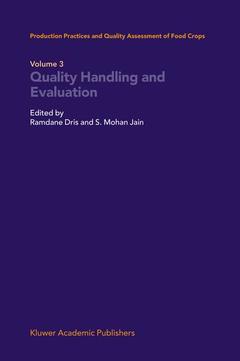Description
Quality Handling and Evaluation, 2004
Coordinators: Dris Ramdane, Jain S. Mohan
Language: English
Subjects for Quality Handling and Evaluation:
Keywords
antioxidant; atmosphere; enzymes; processing; quality assurance
Quality Handling and Evaluation
Publication date: 10-2013
524 p. · 15.5x23.5 cm · Paperback
Publication date: 10-2013
524 p. · 15.5x23.5 cm · Paperback
Production practices and quality assessment of food crops, Vol.3 : quality handling and evaluation
Publication date: 01-2004
524 p. · 15.6x23.4 cm · Hardback
Publication date: 01-2004
524 p. · 15.6x23.4 cm · Hardback
Description
/li>Contents
/li>Comment
/li>
Food quality is becoming an ever-increasing important feature for consumers and it is well known that some food crops are perishable and have a very short shelf and storage life. An effective quality assurance system throughout the handling steps between harvest and retail display is essential to provide a consistently good quality supply of fresh food crops to the consumers and to protect the reputation of a given marketing label. Food manufacturing companies all over the world are incre- ingly focussing on quality aspect of food including minimally processed food to meet consumer demands for fresh-like and healthy food products. To investigate and control quality, one must be able to measure quality-related attributes. Quality of produce encompasses sensory attributes, nutritive values, chemical constituents, mechanical properties, functional properties and defects. Successful postharvest handling of crops requires careful coordination and integration of the various steps from harvest operations to consumer level in order to maintain the initial product quality. Maturity at harvest is one feature of quality of perishable products, it has great influence on their postharvest behavior during marketing. Safety assurance can be part of quality assurance and its focus on minimizing chemical and microbial contamination during production, harvesting, and postharvest handling of intact and fresh-cut of commodities. Essentially, electromagnetic (often optical) prop- ties relate to appearance, mechanical properties to texture, and chemical properties to flavor (taste and aroma).
Enzymes and Quality Factors of Fruits and Vegetables.- Volatile Flavours in Strawberries: A Description of the Components, and How to Analyse Them.- Methods to Evaluate the Antioxidant Activity.- Essential Oil Drugs — Terpene Composition of Aromatic Herbs.- Integral Handling of Banana.- Economics and Organisation of Horticultural Postharvest Production.- Handling Machinery and Damage Inflicted to the Product.- Mechanical Damage During Fruit Post-Harvest Handling: Technical and Physiological Implications.- Harvest and Postharvest Conditions for Apples and Pears.- Rapid Quality Evaluation Techniques of Horticultural Crops.- Table Grape Postharvest Management and Safety Issues.- Fruit Postharvest Technology: Instrumental Measurement of Ripeness and Quality.- Developmental Changes During Strawberry Fruit Ripening and Physico-Chemical Changes During Postharvest Storage.- Processing of Horticultural Crops in the Tropics.- Quality Dynamics and Quality Assurance of Fresh Fruits and Vegetables in Pre- and Postharvest.- Modification of Fruit Ripening by Genetic Transformation.- Quality of Equilibrium Modified Atmosphere Packaged (EMAP) Fresh-Cut Vegetables.
Title is also available as part of a set: Production Practices and Quality Assessment of Food Crops (978-1-4020-1702-5)
© 2024 LAVOISIER S.A.S.



